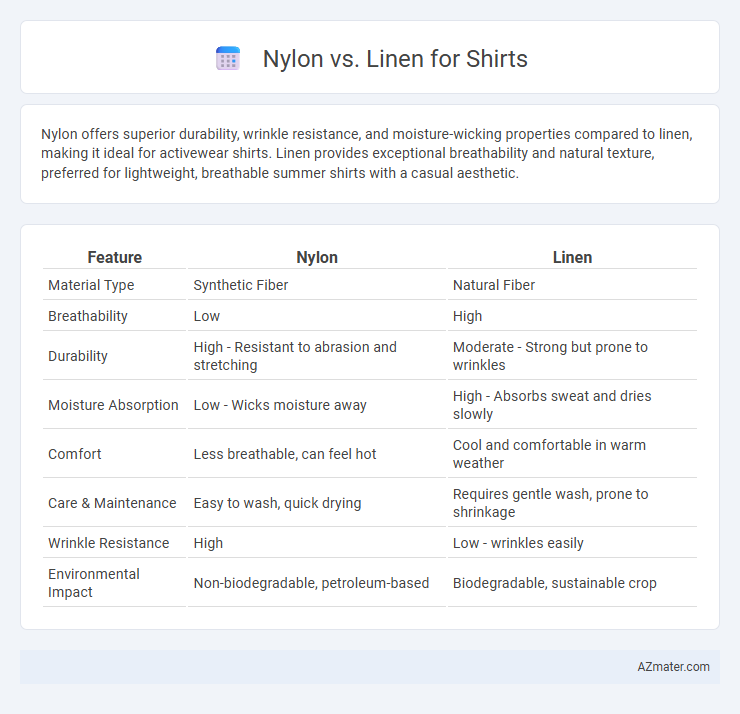Nylon offers superior durability, wrinkle resistance, and moisture-wicking properties compared to linen, making it ideal for activewear shirts. Linen provides exceptional breathability and natural texture, preferred for lightweight, breathable summer shirts with a casual aesthetic.
Table of Comparison
| Feature | Nylon | Linen |
|---|---|---|
| Material Type | Synthetic Fiber | Natural Fiber |
| Breathability | Low | High |
| Durability | High - Resistant to abrasion and stretching | Moderate - Strong but prone to wrinkles |
| Moisture Absorption | Low - Wicks moisture away | High - Absorbs sweat and dries slowly |
| Comfort | Less breathable, can feel hot | Cool and comfortable in warm weather |
| Care & Maintenance | Easy to wash, quick drying | Requires gentle wash, prone to shrinkage |
| Wrinkle Resistance | High | Low - wrinkles easily |
| Environmental Impact | Non-biodegradable, petroleum-based | Biodegradable, sustainable crop |
Overview: Nylon vs Linen Shirts
Nylon shirts offer exceptional durability, moisture-wicking properties, and wrinkle resistance, making them ideal for active and outdoor wear. Linen shirts provide superior breathability, natural texture, and a lightweight feel, perfect for hot weather and casual style. Choosing between nylon and linen depends on the desired balance of performance, comfort, and aesthetic preferences.
Material Composition and Characteristics
Nylon is a synthetic polymer known for its durability, elasticity, and resistance to moisture, making it lightweight and quick-drying for shirts. Linen, derived from flax fibers, offers excellent breathability, natural moisture-wicking, and a textured appearance, ideal for hot weather. The contrasting material compositions result in nylon providing strength and wrinkle resistance, while linen excels in comfort and temperature regulation.
Comfort and Breathability Comparison
Nylon shirts are known for their durability and moisture-wicking properties, but they tend to trap heat and reduce breathability, making them less comfortable in hot weather. Linen, made from flax fibers, offers superior breathability and natural cooling effects, allowing air to circulate freely and keeping the wearer comfortable in warm climates. While nylon provides a lightweight and stretchy fit, linen excels in softness and moisture absorption, making it ideal for all-day comfort in breathable fabrics.
Durability and Longevity
Nylon shirts boast exceptional durability due to their synthetic fibers resisting wear, tear, and stretching far better than natural fibers. Linen, derived from flax plants, offers breathability and comfort but tends to weaken with frequent washing and prolonged exposure to sunlight, reducing its lifespan. Choosing nylon ensures longer-lasting shirts, especially for active use, while linen requires gentle care to maintain fabric integrity over time.
Moisture Wicking and Quick Drying
Nylon excels in moisture-wicking and quick-drying properties, making it ideal for activewear shirts as it efficiently pulls sweat away from the skin and dries rapidly. Linen, while breathable and naturally moisture-absorbent, tends to retain dampness longer and dries more slowly compared to synthetic fibers like nylon. Choosing nylon ensures enhanced comfort during high-intensity activities due to its superior moisture management and fast evaporation rate.
Maintenance and Ease of Care
Nylon shirts offer superior durability and resistance to wrinkles, making them easy to care for with simple machine washing and quick drying times. Linen shirts require more delicate maintenance, often needing hand washing or gentle cycles and ironing to prevent wrinkles and maintain fabric integrity. Choosing nylon reduces efforts in upkeep, while linen demands regular attention to preserve its breathability and natural texture.
Style and Aesthetic Appeal
Nylon shirts offer a sleek, modern aesthetic with a slight sheen that enhances their sporty and contemporary style, making them ideal for activewear or casual fashion statements. Linen, known for its natural texture and breathable fabric, exudes an effortlessly sophisticated, relaxed elegance with a matte finish that complements both casual and semi-formal attire. The choice between nylon and linen for shirts ultimately hinges on desired style preferences, with nylon providing a polished look and linen delivering timeless, organic charm.
Environmental Impact and Sustainability
Nylon production relies heavily on petrochemicals, resulting in high energy consumption and greenhouse gas emissions, while linen is derived from flax plants, which require fewer pesticides and less water, making it a more sustainable fiber. Linen is biodegradable and generally has a lower environmental footprint throughout its lifecycle compared to nylon, which is non-biodegradable and contributes to microplastic pollution. Choosing linen for shirts supports eco-friendly practices by reducing reliance on fossil fuels and promoting renewable, natural resources.
Cost Considerations
Nylon shirts generally offer a lower price point compared to linen due to the synthetic production process, which reduces manufacturing costs and increases durability. Linen, made from natural flax fibers, often commands a higher price because of its labor-intensive harvesting and weaving methods alongside its breathability and premium texture. Cost considerations also include the lifespan of the fabric; nylon's resistance to wear can make it more economical over time, whereas linen may require more careful maintenance to preserve its quality.
Best Use Cases: Choosing the Right Fabric
Nylon shirts excel in moisture-wicking and durability, making them ideal for athletic wear and outdoor activities where quick drying and resistance to abrasion are essential. Linen shirts offer superior breathability and natural cooling properties, perfect for hot climates and casual, stylish summer wear. Choosing the right fabric depends on the need for performance and weather resistance with nylon, or comfort and airflow with linen.

Infographic: Nylon vs Linen for Shirt
 azmater.com
azmater.com